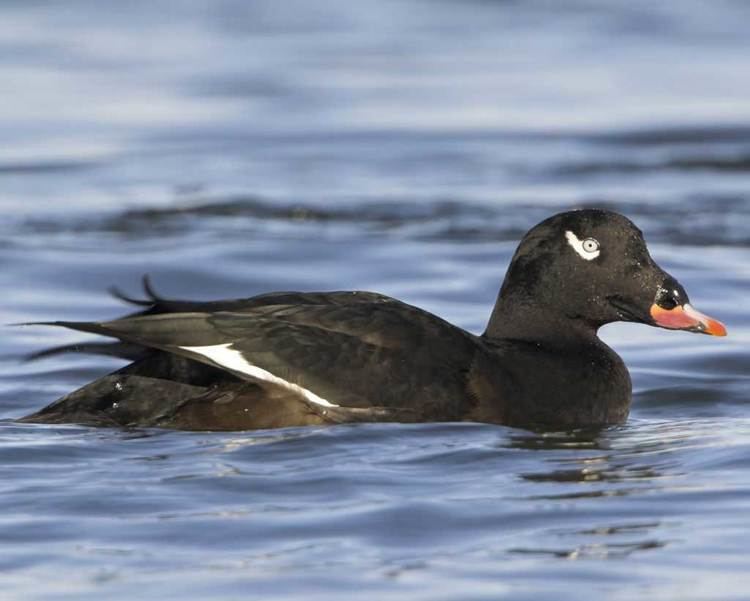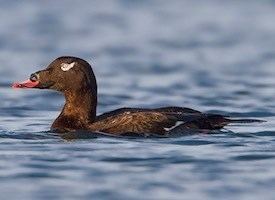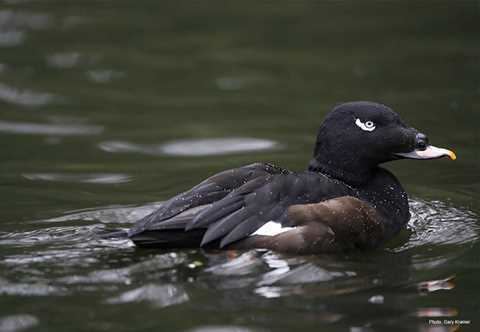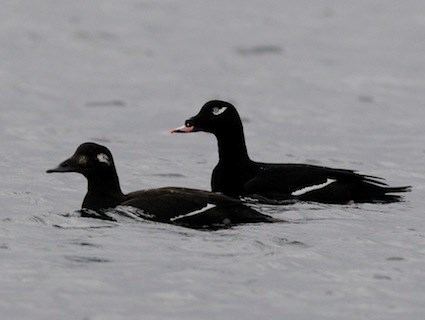Subfamily Merginae Scientific name Melanitta deglandi Rank Species | Phylum Chordata Genus Melanitta Higher classification Scoter | |
 | ||
Similar Scoter, Bird, Surf scoter, Black scoter, Velvet scoter | ||
American white winged scoter
The white-winged scoter (Melanitta deglandi) is a large sea duck. The genus name is derived from Ancient Greek melas "black" and netta "duck". The species name commemorates French ornithologist Côme Damien Degland.
Contents
- American white winged scoter
- White winged scoter mississauga ontario by lucio fazio
- Description
- Taxonomy
- Distribution
- Breeding
- Food
- References

White winged scoter mississauga ontario by lucio fazio
Description

The white-winged scoter is one of three North American scoter species and the largest species of scoter. It is characterised by its bulky shape and large bill. Females range from 950–1,950 g (2.09–4.30 lb) and 48–56 cm (19–22 in), averaging 1,180 g (2.60 lb) and 52.3 cm (20.6 in). She is brown with pale head patches. The male ranges from 1,360–2,128 g (2.998–4.691 lb) and from 53–60 cm (21–24 in), averaging 1,380 g (3.04 lb) and 55 cm (22 in). He is all black, except for white around the eye and a white speculum. This scoter's bill has a black base and a large knob.

There are a number of differing characteristics of the Eastern Siberian race and the American race from Alaska and Canada to west of the Hudson Bay. Males of the American subspecies have browner flanks, dark yellow coloration of most of the bill and a less tall bill knob, approaching the velvet scoter. The Asian form has a very tall knob at the base of its mostly orange-yellow bill. Females are identical in the field.
The Latin binomial commemorates the French zoologist Dr. Côme-Damien Degland (1787–1856).
Taxonomy

It was formerly considered to be conspecific with the velvet scoter, and some taxonomists still regard it as so. These two species, and the surf scoter, are placed in the subgenus Melanitta, distinct from the subgenus Oidemia, black and common scoters. The subspecies stejnegeri has been suggested to be a full species, according to a new study.
Distribution
The white-winged scoter breeds over the far north of Asia east of the Yenisey Basin, and North America. It winters further south in temperate zones, on the Great Lakes, the coasts of the northern United States and the southern coasts of Canada, and Asia as far south as China. It forms large flocks on suitable coastal waters. These are tightly packed, and the birds tend to take off together.
Breeding
The lined nest is built on the ground close to the sea, lakes or rivers, in woodland or tundra. 5–11 eggs are laid. The pinkish eggs average 46.9 mm (1.85 in) in breadth, 68.2 mm (2.69 in) in length and 82.4 g (2.91 oz) in weight. The incubation period can range from 25 to 30 days. After about 21 days, neighboring females may start to behave aggressively towards other nesting females, resulting in confusion and mixing of broods. By the time she is done brooding, a female may be tending to as much as 40 offspring due to the mixing from these conflicts. The female will tend to her brood for up to 3 weeks and then abandon them, but the young will usually stay together from another 3 weeks. Flight capacity is thought to be gained at 63 to 77 days of age.
Food
In freshwater, this species primarily feeds on crustaceans and insects; while in saltwater areas, it feeds on molluscs and crustaceans. The favorite foods of the American (sub)species are an amphipod (Hyalella azteca) in freshwater, and rock clams (Protothaca staminea), Atlantic razor clams (Siliqua spp.), and Arctic wedge clams (Mesodesma arctatus).
